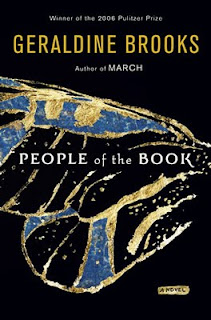People of The Book
When a book conservator encounters a centuries-old Hebrew text, the Sarajevo Haggadah, she feels a “strange and powerful” sensation, something “between brushing a live wire and stroking the back of a newborn baby’s head.” It’s spring 1996 in Sarajevo, and Hanna has been called in to examine the book before it’s put on display.

Dancing between present day and years gone by, this book is not only filled with vivid descriptions and colorful language but is also laced with historical and cultural information that provides a solid connection between you and each time period.
With a writing style that traipses through time, one could get lost among the fact and fiction. But aside from a few meaningless sub-plots, the book refuses to let you go.

(actual page from the Sarajevo Haggadah that is referred to many times in the book)*
Lavish descriptions of ink colors, detailed fabric patterns and heart-breaking tales of families in danger, the book offers much range. Like the threads twisting into the ancient book's parchment, Geraldine Brooks' story telling weaves through the tale delicately holding the characters together.
The author has definitely done her research. The reader enters the world of book conservation, religious history and facts about the actual book's discovery. But Brooks' story telling makes the technical tidbits enjoyable drops of knowledge. As a researcher, some of my favorite passages include bits about how mere dust from a page can tell a story.
After reading this, I feel I might be able to apply for a job at the Smithsonian.
What did you think of the book?
*photo from http://www.talmud.de/sarajevo/textbildansicht_1.html

Dancing between present day and years gone by, this book is not only filled with vivid descriptions and colorful language but is also laced with historical and cultural information that provides a solid connection between you and each time period.
With a writing style that traipses through time, one could get lost among the fact and fiction. But aside from a few meaningless sub-plots, the book refuses to let you go.

(actual page from the Sarajevo Haggadah that is referred to many times in the book)*
Lavish descriptions of ink colors, detailed fabric patterns and heart-breaking tales of families in danger, the book offers much range. Like the threads twisting into the ancient book's parchment, Geraldine Brooks' story telling weaves through the tale delicately holding the characters together.
The author has definitely done her research. The reader enters the world of book conservation, religious history and facts about the actual book's discovery. But Brooks' story telling makes the technical tidbits enjoyable drops of knowledge. As a researcher, some of my favorite passages include bits about how mere dust from a page can tell a story.
After reading this, I feel I might be able to apply for a job at the Smithsonian.
What did you think of the book?
*photo from http://www.talmud.de/sarajevo/textbildansicht_1.html
Comments
The stories really illustrated how some things can weave in and out of so many different lives. One of my favorite moments was the main character leaving samples of everything and a little extra for future generations, now that is a scientist.